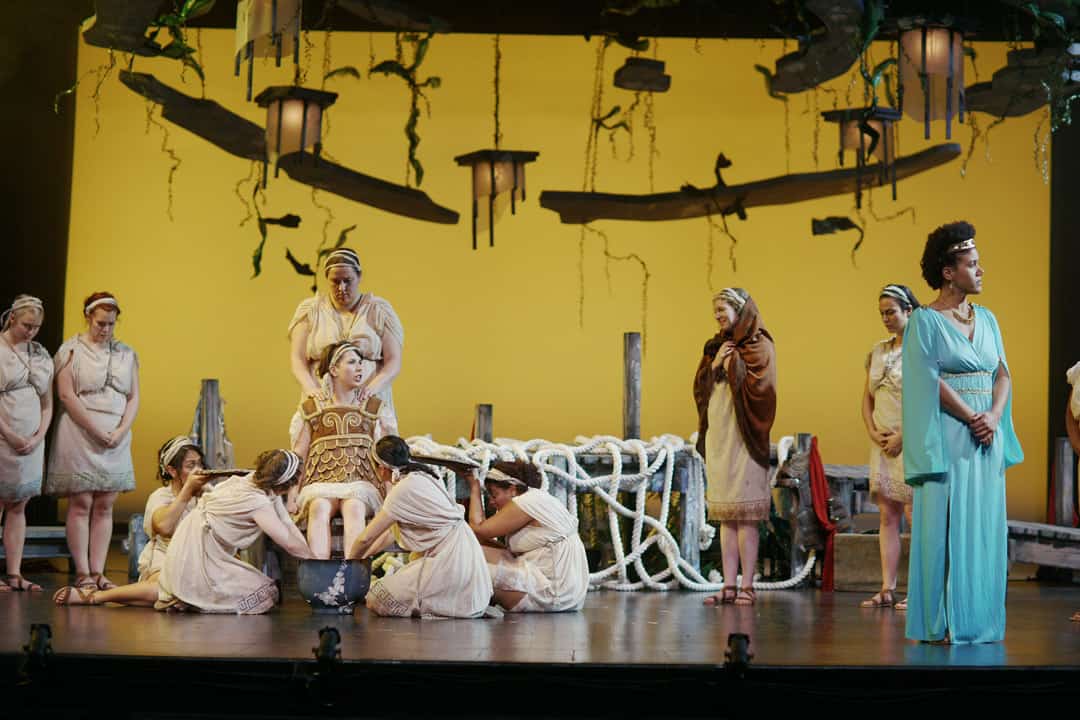Rating: 4.5/5 stars
Since 2002, Hart House Theatre has staged a Shakespearean production every winter, alternating between a comedy and a tragedy each season. This tradition was replaced, or simply suspended, this year, but it is a loss that is noticed minimally, if at all, if only for the reason that Shakespeare has been replaced by a more contemporary bard: Margaret Atwood.
Atwood’s The Penelopiad is a drama on the level of Shakespeare. It is a retelling of Homer’s The Odyssey from a female-centric lens: that of Penelope, wife of Odysseus and the titular character. In typical Atwood fashion, audiences receive the story of The Odyssey through Penelope’s voice and experiences.
The Penelopiad is composed of an all female-identifying cast of 13, and a mostly female-identifying production team. They are a wonderfully large and diverse troupe, who tell the story of Penelope’s life, her marriage to Odysseus, his absence for 20 years, his eventual return, and its implications.
At the beginning of the play, Penelope, who often speaks to the audience in a painfully honest fashion, reveals that her 12 maids were murdered and that she is to blame. The remainder of the play seeks to expose the culmination of such an event, in turn questioning female agency and the importance of female narrative, and perhaps most importantly, the silencing of women. This play is saturated with typical Atwoodian motifs and themes; it is a wonderful replacement for the often male-centric drama found in Shakespeare.
Apart from Amanda Cordner, who plays Penelope, almost all members of the cast play multiple characters. Each is both one of Penelope’s maids as well as a male character, such as Odysseus himself, or a minor character, such as Helen of Troy. The multiplicity of roles for each actor not only challenges typical gender stereotypes, but reinforces the multiplicity of narratives that Atwood emphasizes in her feminist retelling of this myth.
Director Michelle Langille’s staging of The Penelopiad is unsurprisingly exciting and inventive. Soft and dreamy background music can be heard almost constantly throughout the play, an unusual detail that perhaps emphasizes the uniqueness of the female voice. The set itself is mystical and well-occupied by the large cast, who move about frequently, employing props, such as large ropes, which at one point are used to mimic Penelope’s famous weaving.
Hart House Theatre productions almost always make excellent use of the entire theatre, not just the stage, and this production is no different. Even the lighting is memorable and even physical at times, used to blind the audience in an unusual and powerful effect.
Ultimately, The Penelopiad is an excellent production and well worth seeing. Stand out performances include Cordner, whose strength and dedication to her character truly carry the show. Much of the rest of the cast are appearing in their Hart House debuts, and one can only hope that they will be on this campus stage again soon.
Of course, one can also hope that the U of T alum herself has seen this excellent production. As a U of T student myself, it is particularly exciting to see such an epic work written by an alum and staged in a campus theatre. If such pride is not enough for you to enjoy the show, its own merits should do the trick.


